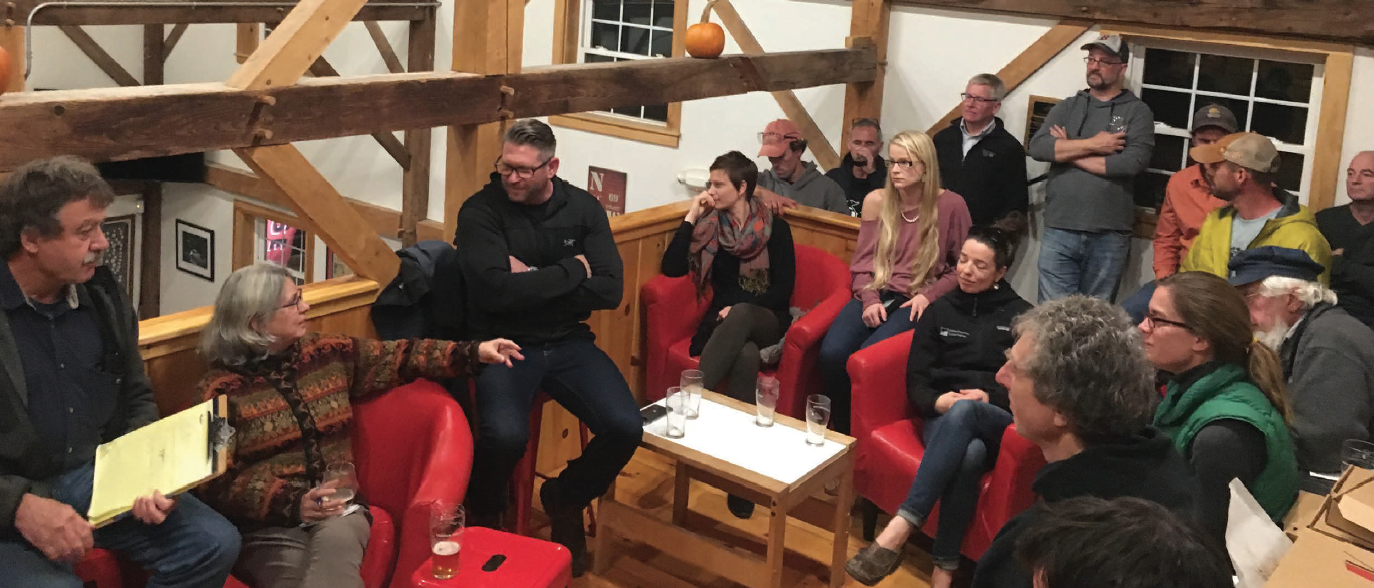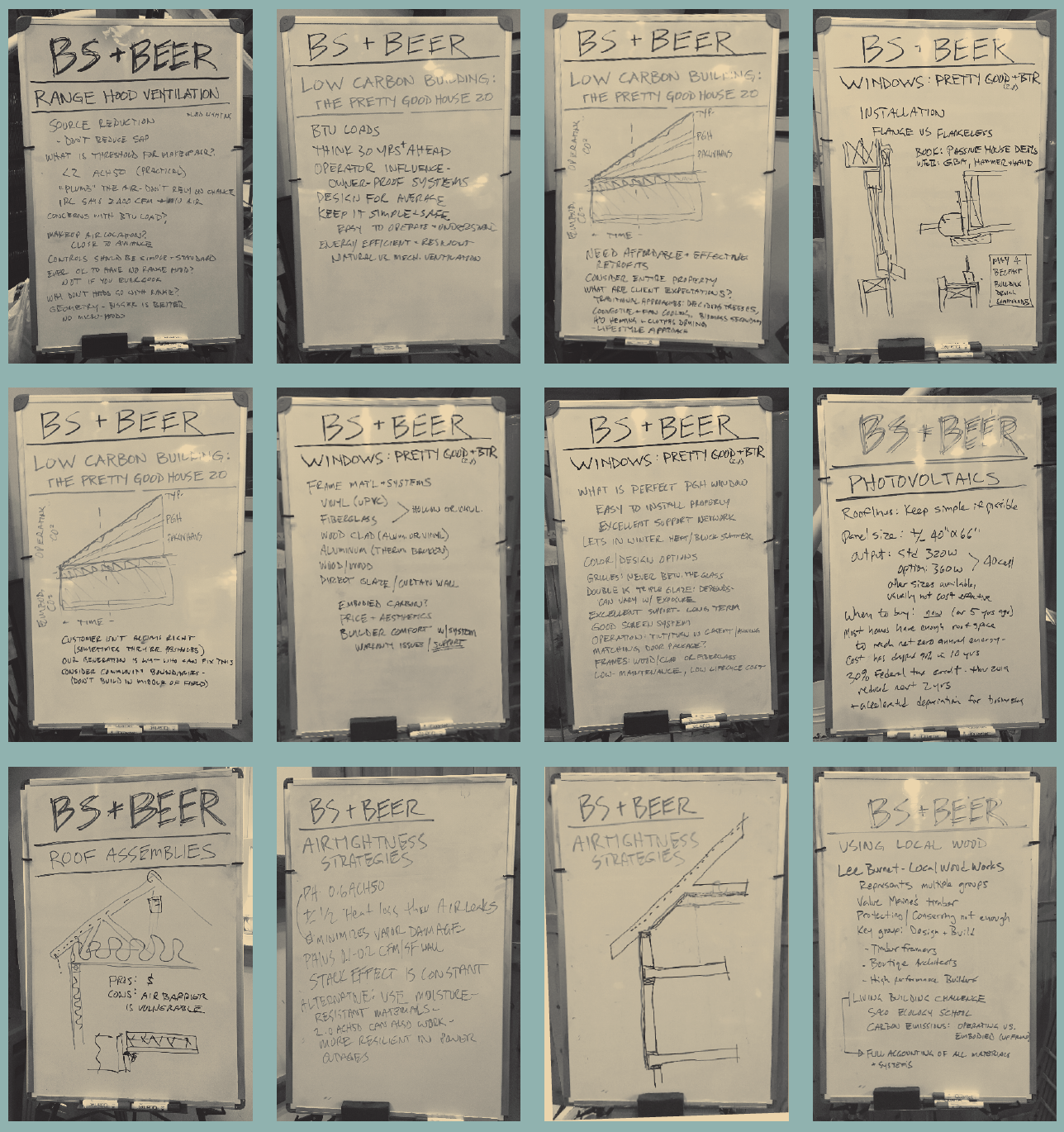BS* + Beer
*Building Science
Architect Sarah Holland talks at BS + Beer at Lake St. George Brewing Company in Liberty. Her business partner, David Foley, is holding a clipboard. Chris Corson of Ecocor is near her left hand. Others in the group include architect Ashley Hopwood Farrar of Kingfield, Kelsey Smith of Pinnacle Window Solutions, Kat Carlson of Maine Mountain Timber Frames in Avon, and Jim Bahoosh of Unity in the foreground facing Sarah. PHOTO COURTESY MICHAEL MAINES
BY AMY PARADYSZ
When residential designer Michael Maines moved from Portland to Palermo, he didn’t want to give up the monthly Building Science Discussion Group at Performance Building Supply he had been part of since 2009. After a couple years of trying to make the 90-minute drive to talk shop with other designers, builders and building science nerds, in May 2018 he hosted the first meeting of what he dubbed, “BS + Beer.”
To Maines’ surprise, 20 people showed up at Lake St. George Brewing Company in a restored timber-frame barn in Liberty (population roughly 950) in Waldo County to talk about, of all things, windows.
“Nothing except the goofy name was my idea, but that seems to have struck a chord,” says Maines, who has since seen BS + Beer groups spring up in Connecticut, Missouri, Tennessee and Minnesota.
Maines picks a topic, anything from foundation waterproofing to roof venting, and emails participants a couple of weeks in advance, sometimes with links to relevant articles. He shows up at the brewery on the third Thursday of the month with several pizzas, a bag of chips and a whiteboard, and a dozen or two people with an interest in building science join him.
“I throw a topic on the board and introduce it, or a guest expert introduces it, for about five to twenty minutes,” Maines says. “Then it’s an open but moderated discussion. One guy likes foam, another doesn’t, and you learn and talk about the merits and drawbacks.”
Even with a bachelor’s degree in structural engineering, 15 years of experience as a residential designer, and 25 years total in the building industry, Maines says there’s always more to learn about building science.
“I love going to conferences; you pay a bunch of money to hear experts give presentations,” he says. “But what we’re doing here is affordable, low-key and low-effort. It’s really just peer education. I learn from everyone in the room.”
Builder Jim Bahoosh says it helps to come with an open mind and the willingness to, for example, be convinced that a blower door is indeed a good business investment (as he was).
A sampling of white board notes created at BS & Beer over the past two years where discussions have ranged from solar to roof assemblies to airtightness strategies and beyond.
Lee Burnett of Local Wood Works talks about using local lumber at a recent BS + Beer meeting at Lake St. George Brewing Company in Liberty. PHOTO COURTESY MICHAEL MAINES.
“It’s really nice to get together with a group of peers and try to do what you do better,” Bahoosh says. “I find it extremely valuable, being part of a group where people are willing to share their skills. Building science can get as complicated as you want it to get. As a builder, I want to understand why we do something, but I’m even more interested in how.”
Even with more than four decades of building experience, Bahoosh says there are always new products to consider — and he’d rather hear about them from peers than from sales reps. “I’m interested in hearing from other people in the industry how well the product actually works,” he said.
David Gibson, a sales engineer with ReVision Energy and a homeowner renovating an 1822 post-and-beam farmhouse to get it to net-zero energy, describes BS + Beer as “a popcorn of ideas.”
Travis Brungardt and Joe Cook of Catalyst Construction in Kansas City, Missouri, created a coaster for BS + Beer, a group name first coined by residential designer Michael Maines of Palermo, Maine.
“The discussion can be a little on the technical side and tends to be focused more on new construction,” he says. “But there are several of us who are working on renovations and asking questions.”
For example, when Gibson put in a new window, he got tips on flashing (the barrier that keeps water from getting into the wall).
“The real benefits are educating and inspiring people in the construction industry to improve how and what they build,” says Steve Konstantino, who has hosted the Building Science Discussion Group at Performance Building Supply in Portland since 2009. “My mission has always been to help builders build better.”
Architect Emily Mottram, a regular at both the Portland discussion group and BS + Beer, has a weekly podcast called E3 — Energy and Efficiency with Emily — that addresses building science, architecture and female entrepreneurship. BS + Beer discussions are fodder for her podcasts, which are sometimes a debate with Maines, to keep things interesting.
Mottram says the mix of professionals and regular homeowners asking questions at BS + Beer keeps the dialogue down to earth and helps her better communicate with clients. “Once you know a lot, you forget what you need to tell people,” she says.
Another shift in perspective between the two groups that Mottram has observed is the primary fundamental motivation behind interest in building science in urban versus rural areas.
“Rural communities tend not to be as invested in the environmental aspect but more invested in providing affordable housing,” Mottram says. “Building science can definitely help you to be more affordable. Just building a house doesn’t mean you can afford to live in it — to heat and cool it — later. So, we ask, how can we do this better? You can use building science to help with climate emissions, but it’s really about how all the parts and pieces of a building interact. Most of what we talk about has to do with water, water vapor, air and thermal control.”
The exchange of ideas sometimes comes from unlikely sources — like chemistry teacher Jeff Cleaveland of Hall- Dale High School, who happened to see a notice about BS + Beer at the brewery.
“It’s interesting for me to take what I know in chemistry and apply it to, for example, the science of slowing down the movement of heat and moisture in a home,” Cleaveland says. “That’s the stuff I find pretty cool, talking about windows, insulation and vapor penetration.”
Want to follow the BS + Beer Show? Sign up for their email list here. And find recordings of The BS + Beer Show in the Building Science Blog section here.
This article first appeared in the Spring & Summer 2020 issue of Green & Healthy Maine HOMES magazine. Subscribe today!






